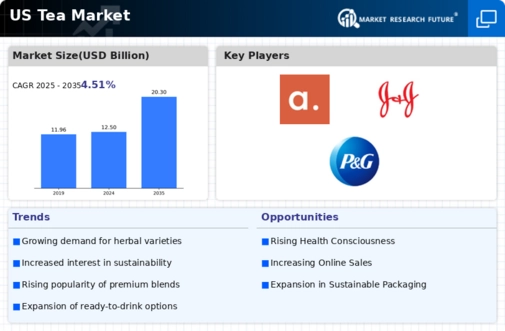Rising Demand for Specialty Teas
The tea market in the US is experiencing a notable shift towards specialty teas, which are perceived as premium products. This trend is driven by consumers seeking unique flavors and health benefits associated with various tea types, such as herbal, green, and oolong. According to recent data, specialty tea sales have increased by approximately 20% over the past year, indicating a growing consumer preference for high-quality, artisanal options. This demand is likely to continue influencing the tea market, as brands innovate to offer diverse blends and flavors that cater to discerning palates. The emphasis on quality over quantity is reshaping purchasing behaviors, with consumers willing to pay a premium for unique tea experiences.
Expansion of Online Retail Channels
The expansion of online retail channels is emerging as a crucial driver in the tea market. With the increasing reliance on e-commerce for grocery shopping, tea brands are capitalizing on this trend by enhancing their online presence. Recent data suggests that online tea sales have grown by over 30% in the past year, indicating a shift in consumer purchasing habits. This growth is likely to continue as brands invest in digital marketing strategies and user-friendly online platforms. The convenience of online shopping, coupled with the ability to access a wider variety of products, is reshaping the tea market landscape, making it essential for brands to adapt to this evolving retail environment.
Cultural Influences and Social Trends
Cultural influences and social trends are playing a pivotal role in shaping the tea market. The increasing popularity of tea culture, particularly among younger demographics, is fostering a community-oriented approach to tea consumption. Social media platforms are amplifying this trend, as consumers share their tea experiences and preferences online. This cultural shift is reflected in the growing number of tea cafes and specialty shops across the US, which cater to a community of tea enthusiasts. As the tea market evolves, it is likely to see a rise in collaborative events and tea tastings that promote social interaction and cultural appreciation, further enhancing consumer engagement.
Increased Awareness of Health Benefits
The tea market is significantly influenced by the rising awareness of the health benefits associated with tea consumption. Research indicates that various types of tea, particularly green and herbal varieties, are linked to numerous health advantages, including improved digestion and enhanced mental clarity. As consumers become more health-conscious, the demand for functional teas that promote wellness is likely to grow. Recent surveys show that approximately 60% of tea drinkers in the US prioritize health benefits when selecting their beverages. This trend is expected to drive innovation in the tea market, as brands develop products that highlight specific health claims, thereby attracting health-oriented consumers.
Innovations in Packaging and Convenience
Innovative packaging solutions are emerging as a significant driver in the tea market. Brands are increasingly adopting eco-friendly materials and convenient formats, such as single-serve tea bags and ready-to-drink options. This shift aligns with consumer preferences for convenience and sustainability. Recent statistics indicate that ready-to-drink tea sales have surged by 15% in the last year, reflecting a growing demand for on-the-go beverage options. As consumers lead busier lifestyles, the tea market is likely to see continued growth in convenient packaging solutions that enhance the overall consumer experience. This trend not only caters to the need for convenience but also addresses environmental concerns, as brands strive to reduce their carbon footprint.














Leave a Comment